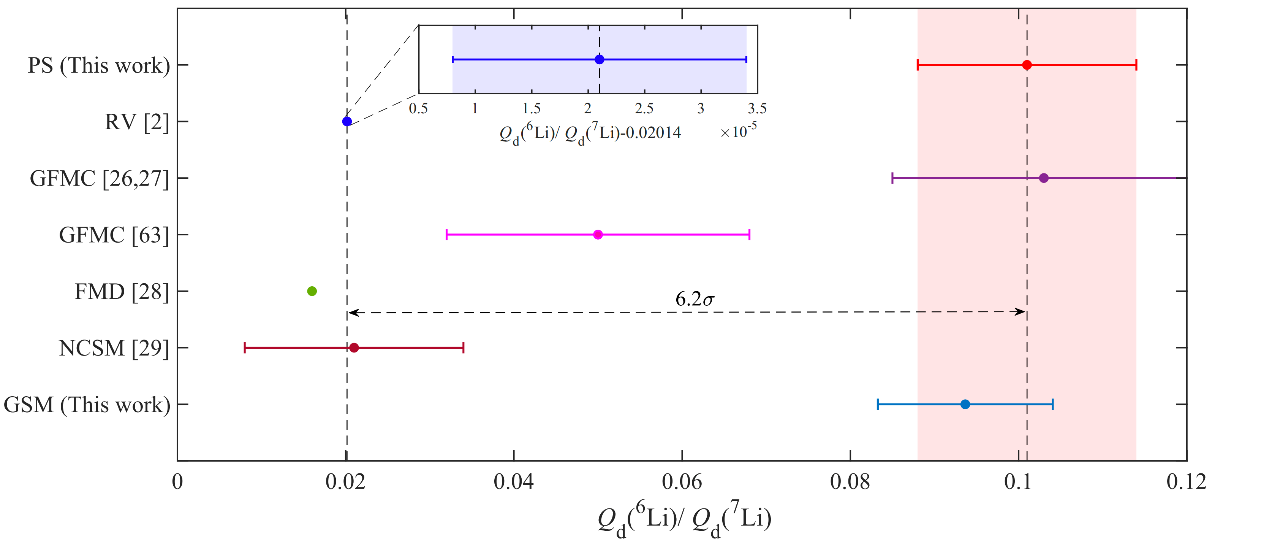Recently, the Innovation Academy for Precision Measurement Science and Technology (APM), in collaboration with multiple research institutions including the University of New Brunswick in Canada, the University of Windsor in Canada, Zhejiang Sci-Tech University, Hainan University, and the Institute of Modern Physics, has made significant progress in the research on precision spectroscopy of lithium ions. The research team, for the first time, directly extracted key parameters such as the electric quadrupole moment of the lithium atomic nucleus through atomic spectroscopy. The results revealed a significant discrepancy of up to 6.2σ between the measured electric quadrupole moment of the ⁶Li nucleus and the currently recommended value based on molecular spectroscopy, posing a new challenge to existing molecular spectroscopy measurement methods. Meanwhile, this achievement provides a sensitive benchmark for testing non-perturbative nuclear theories and is expected to drive in-depth research into the internal interactions within atomic nuclei.
The research team, leveraging a self-developed metastable lithium-ion beam source apparatus and building upon a previous saturated fluorescence spectroscopy scheme, applied the optical Ramsey method to ion beam measurement for the first time. This approach compressed the spectral linewidth (full width at half maximum, FWHM) from 50 MHz to 5 MHz, ultimately enhancing the measurement precision of Li⁺ hyperfine structure spectra from 50 kHz to 10 kHz. The achieved precision represents a one- to two-order-of-magnitude improvement over previously published results by international research teams. Through high-precision theoretical calculations, the research team further directly extracted nuclear parameters of lithium from atomic spectra. The results revealed a significant deviation between the measured electric quadrupole moment of ⁶Li and the existing recommended value, yet it showed good agreement with the theoretical nuclear structure calculations based on the Gamow shell model. Figure 1 illustrates the ratio of the electric quadrupole moments of ⁶Li and ⁷Li nuclei obtained using multiple methods.

The ratio of the electric quadrupole moments of ⁶Li/⁷Li nuclei measured by different methods
PS represents the results obtained by our research team, RV denotes the recommended values based on molecular spectroscopy, while the others are computational results from various theoretical models. Among them, GSM refers to the nuclear structure theoretical calculation results derived from our study using the Gamow shell model
The experimental team led by GAO Kelin and GUAN Hua and the theoretical team led by SHI Tingyun have collaborated on helium-like lithium ion research for over a decade. The ion beam source apparatus independently developed by the experimental team has achieved internationally advanced levels in key performance indicators such as beam intensity and stability. Meanwhile, the high-precision computational package for few-electron atomic systems developed by the theoretical team has provided robust theoretical support for precise spectroscopic measurements of lithium ions. Currently, the team has achieved a series of significant research outcomes in lithium ion-related studies, with this latest research result representing another milestone advancement in their ongoing work.
The relevant research findings were published as a Letter in Physical Review A. Researcher GUAN Hua from APM and associate professor QI Xiaoqiu from Zhejiang Sci-Tech University are the co-first authors of the paper, while researcher SHI Tingyun and researcher GAO Kelin from APM are the co-corresponding authors.
This research work was supported by the National Natural Science Foundation of China (NSFC), the Strategic Priority Research Program of the Chinese Academy of Sciences, the Youth Innovation Promotion Association of the Chinese Academy of Sciences, and the Young Team Plan for Basic Research under Stable Support from the Chinese Academy of Sciences.
Link to the article: https://doi.org/10.1103/s61z-b1t5
